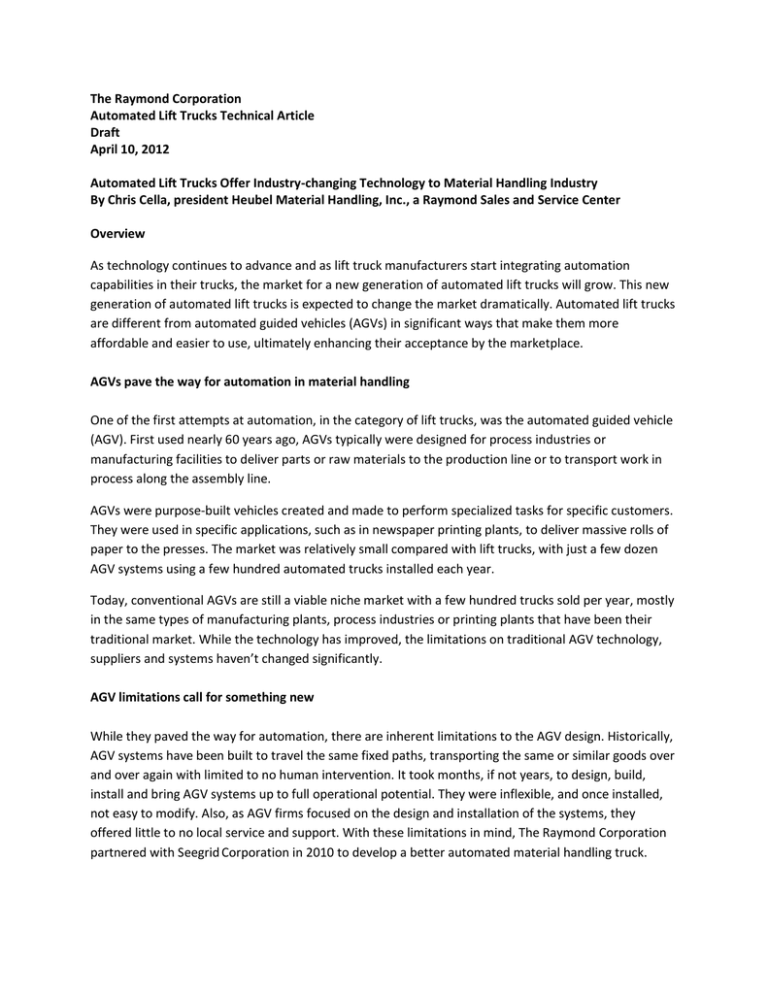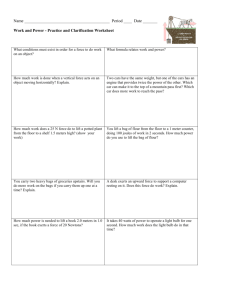The Raymond Corporation Automated Lift Trucks Technical Article Draft April 10, 2012
advertisement

The Raymond Corporation Automated Lift Trucks Technical Article Draft April 10, 2012 Automated Lift Trucks Offer Industry-changing Technology to Material Handling Industry By Chris Cella, president Heubel Material Handling, Inc., a Raymond Sales and Service Center Overview As technology continues to advance and as lift truck manufacturers start integrating automation capabilities in their trucks, the market for a new generation of automated lift trucks will grow. This new generation of automated lift trucks is expected to change the market dramatically. Automated lift trucks are different from automated guided vehicles (AGVs) in significant ways that make them more affordable and easier to use, ultimately enhancing their acceptance by the marketplace. AGVs pave the way for automation in material handling One of the first attempts at automation, in the category of lift trucks, was the automated guided vehicle (AGV). First used nearly 60 years ago, AGVs typically were designed for process industries or manufacturing facilities to deliver parts or raw materials to the production line or to transport work in process along the assembly line. AGVs were purpose-built vehicles created and made to perform specialized tasks for specific customers. They were used in specific applications, such as in newspaper printing plants, to deliver massive rolls of paper to the presses. The market was relatively small compared with lift trucks, with just a few dozen AGV systems using a few hundred automated trucks installed each year. Today, conventional AGVs are still a viable niche market with a few hundred trucks sold per year, mostly in the same types of manufacturing plants, process industries or printing plants that have been their traditional market. While the technology has improved, the limitations on traditional AGV technology, suppliers and systems haven’t changed significantly. AGV limitations call for something new While they paved the way for automation, there are inherent limitations to the AGV design. Historically, AGV systems have been built to travel the same fixed paths, transporting the same or similar goods over and over again with limited to no human intervention. It took months, if not years, to design, build, install and bring AGV systems up to full operational potential. They were inflexible, and once installed, not easy to modify. Also, as AGV firms focused on the design and installation of the systems, they offered little to no local service and support. With these limitations in mind, The Raymond Corporation partnered with Seegrid Corporation in 2010 to develop a better automated material handling truck. What is an automated lift truck? An automated lift truck is a conventional lift truck that is guided by a multi-head camera system that uses fixed points of reference to move goods throughout a warehouse. The truck does not require any lasers, tape, wire or magnets for guidance. This unique machine offers a number of benefits to users, particularly in the right application. These automated lift trucks can be driven manually or scheduled to perform on their own running automated routes. They are easy to use and install, and create economical and operational advantages. How does it work? The automated lift truck uses an intuitive camera lens to guide the vehicle throughout the warehouse. These trucks “learn” routes and the actions to perform on a route while an operator drives. As an example, on a Raymond® Automated Lift Truck, a Seegrid® multi-head camera system records image data while the truck is being driven. Then, the Seegrid software and hardware convert image data into a travel path the truck can follow. If the truck senses an obstruction, it will slow down and eventually stop until the obstruction is removed, and then continue on its way. An operator must manually load pallets, but the automated lift truck automatically will drop pallets at preprogrammed locations. Automated lift trucks learn additional actions such as horn honks, stops at intersections and pallet drops from the operator driving it in learning mode. Those routes are then used when the truck is in automatic mode without the operator to transport material in the warehouse or manufacturing plant. Once saved, a route can be used as often as needed. Using a Raymond Automated Lift Truck can save up to 15 miles of travel in a virtually unlimited number of routes. Typically, a warehouse can have an automated lift truck running routes and moving product within three to five hours. This is a significant improvement when considering it may take several days to several weeks to train a new employee on warehouse routes and the intricacies of a traditional lift truck. How do automated lift trucks compare with a standard lift truck? There are a number of differences to consider when comparing an automated lift truck and a traditional lift truck. Automated lift trucks can be manually operated just like a traditional lift truck; however, the automated lift truck also can drive itself through the warehouse, using its intuitive vision guidance system. Traditional lift trucks are less expensive than an automated lift truck to purchase; however, automated lift trucks can show a better return on investment if used in the correct application. The automated lift truck runs at a full maximum speed, when being manually operated, of up to 9 mph unloaded. When utilized running automated routes the unit is required to travel at a maximum speed of 3.8 mph. The reduced travel speed becomes less of a factor when considering that automated lift trucks can run 24 hours per day, seven days per week, 365 days per years, without coffee breaks, vacations or sick days. How do automated lift trucks differ from AGVs? Automated lift trucks differ from AGVs in various ways. Automated lift trucks offer significant advantages over AGVs in ease of use, lead time for implementation, flexibility, local service and support and ROI. AGVs cost comparatively more than automated lift trucks, and they take a significant amount of time to install, primarily due to fixed guidance requirements and warehouse integration. This also makes AGVs far less flexible than automated lift trucks, as altering routes can be quite complex. And while they typically travel the same speed and will move the same number of pallets throughout a warehouse, it is an automated lift truck’s flexibility, price comparison and minimal implementation time that set it apart from the AGV. One advantage the AGV has over the automated lift truck is loading. At this time, the automated lift truck cannot load the pallet forks on its own, this takes human interaction. However, this is something users may see in a future version of the automated lift truck. Automated lift trucks are more affordable Perhaps one of the most notable advantages of an automated lift truck, compared with an AGV, is the price. With an average AGV running somewhere between $125,000 and $155,000, automatic lift trucks typically cost about a half to two-thirds the price. Additionally, with the efficient installation process, warehouses are seeing a return on their investments much sooner with automated lift trucks. For example, when considering the installation of three AGVs and taking the integration time into account, this can cost a warehouse an average of $400,000 to $500,000, whereas a warehouse installing three automated lift trucks, again considering the integration time, will experience an approximate cost of $235,000. And while both AGVs and automated lift trucks reduce labor costs, it is the variation in installation costs and purchase price that truly makes automated lift trucks more advantageous. Payback on an automated lift truck project can be less than one year depending on labor rates, shifts operated per day and truck usage. Using the same labor rates, shifts per day and truck usage, payback in a conventional AGV project could be two to three years or longer. Automatic lift trucks are easy to install As automated lift trucks do not require lasers, tape, wire or magnets for guidance, routes can be set up quickly with no changes to a building’s infrastructure and no integration with IT, ERP or warehouse management systems. This means automated lift trucks can learn routes and begin doing useful work in a matter of three to five hours instead of the weeks or months, which is often required to implement an AGV system. Automatic lift trucks offer flexibility Automated lift trucks are flexible and offer a number of benefits. While they run on preplanned routes, these routes are not fixed; in fact, an automated lift truck’s route can be modified as needed. Additional routes can easily be added, removed or adapted to suit throughput needs from season to season, week to week or shift to shift. Also generating time savings is the ability to schedule runs to the battery room. Route changes can happen in very little time compared with an AGV route alteration. For example, it may take 30 to 45 minutes to create or modify a given automated lift truck route. It likely takes at least several days to change a comparable conventional AGV route. Another significant benefit of automated lift trucks is that humans can operate them in manual mode like a conventional lift truck. This “operator optional” capability affords some significant benefits. If the need arises, an operator can use the truck like a conventional lift truck just by stepping into the operator compartment and taking control of the handle. This is something traditional AGVs cannot do. Most conventional AGVs do not even feature an operator compartment or on-board controls. Also, because automated lift trucks look very much like conventional lift trucks, with additional features, and can run in both automated and man-operated modes, workers will develop a higher comfort level with them more quickly. The ability to easily adapt to automated lift trucks and the flexible nature of its features, make these automated lift trucks “user friendly” and highly favored over AGVs. Automated lift trucks reduce labor costs As labor costs are known to be 70 percent to 80 percent of the hourly cost of operating a lift truck, automated lift trucks offer an innovative way to reduce labor costs for specific material handling tasks and improve efficiency. Especially in industries with high turnover rates, this ability to maintain scheduled movements of goods and reduce operational costs is crucial. For example, a warehouse installing four automated lift trucks — each of which will run 100 routes per shift, two shifts per day — will save an average of 240 man hours per week or 12,480 hours per year while still maintaining the same number of pallets moved throughout the warehouse. This unique advantage allows warehouse managers to reallocate those man hours into more important tasks. So, instead of allocating man hours to driving the truck from point A to point B 200 times per day, managers can now assign operators to running two, three or four of these trucks at one time, therefore leveraging labor and increasing the bottom line. Where are automated lift trucks best applied? The automated lift truck is best suited for medium to large manufacturing facilities and distribution centers that make long transport runs. Any transport run of 200 feet or more that is moving at least 200 pallets per day on a regular basis might benefit from the deployment of an automated lift truck. Larger operations moving a substantial number of pallets per shift over longer distances typically are the best applications for the automated lift truck. Distribution centers may have fewer regular route patterns and perform different activities on different shifts but still can benefit by automating repetitive horizontal transport assignments. Because they can be installed and start working in hours, rather than weeks or months, automated lift trucks could even be part of a material handling dealer’s rental fleet and be deployed for peak season usage. Also, as operators are needed only to program automated lift trucks, they also could be used in areas storing high-value goods or controlled substances, or in any parts of a warehouse or manufacturing plant where it’s preferable to have as few humans as possible for security reasons. Horizontal transport tasks where the automated lift truck may apply include: Completing long hauls in distribution centers Moving goods from the dock to pick-and-drop (P&D) stations for put-away Moving pallets from P&D stations to docks Transporting materials from the end of a production line to the warehouse Delivering components and parts to production lines What are the limitations? There are some limitations to automated lift truck technology. For example, an operator is required to load pallets on the forks; automated lift trucks will not do that automatically. Because the system is vision-guided, automated lift trucks need adequate lighting when being taught and when running routes. Subsequently, they will not run in “lights out” facilities. Automated lift trucks also need some geography to recognize routes, and will not work well in bulk stack areas that change frequently. While enhancements are in development, automated lift trucks currently cannot travel between freezers and ambient temperature areas because this temperature change causes condensation to accumulate on the camera lenses, inhibiting the vehicles’ vision. Also, there are no automated lift trucks currently available for environments that require EE-rated trucks. The future of automated lift trucks New technologies are cheaper and easier to implement than ever before. The flexibility of automated lift truck technology and the ease of installation and use will increase uptake. The automated lift truck also will be capable of being powered by hydrogen fuel cells and advanced battery technologies. Adoption of automated lift trucks will happen relatively quickly in the lift truck industry over the next few years.




